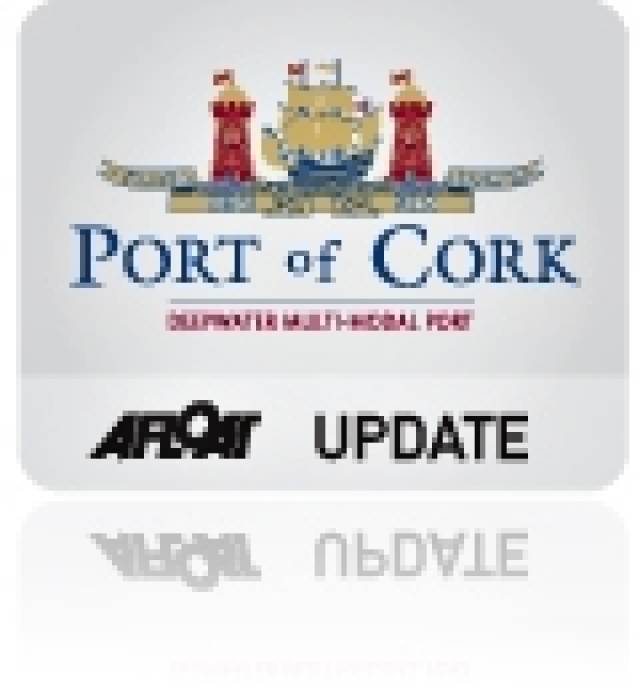#portofcork – Total traffic through the Port of Cork and Bantry Bay Port Company in 2014 reached a total of 10.1 million tonnes. Following the transfer of Bantry Bay Harbour to the Port of Cork Company in January 2014, both Ports performed well in the circumstances with some sectors performing strongly while others experienced a decline due to a favourable harvest for Irish farmers in the summer and autumn of 2014 when compared to 2013.
Container volumes through both Tivoli and Ringaskiddy Container Terminals in the Port of Cork showed an exceptional growth of 13% compared to 2013 figures with over 190,000 TUEU's handled. This is very encouraging and the Port is confident that this level of growth can be maintained through 2015 and beyond with expectations that we will be at record numbers of container import and export
Despite the excellent performance in the container business, overall traffic in both Ports experienced a drop of 4% in trade on 2013. This was primarily due to unseasonably fine weather in 2014 which saw a reduction of 22% in both animal feed and cereal imports and generally challenging market conditions which affected overall traffic. An improvement in financial performance is expected in 2015 over the same period.
Oil traffic through Whitegate Oil Refinery, currently owned and operated by Phillips 66 continues to have a significant impact on the overall traffic through the Port of Cork. Oil traffic through the Port of Cork in 2014 experienced a marginal 1.5% decrease on 2013 primarily due to the maintenance shut-down in the Whitegate refinery which affected refining six weeks in July and August of 2014. Traffic from the Bantry Bay Oil Storage Terminal also currently operated by Phillips 66 which accounts for 100% of the commercial traffic through Bantry Bay Port, saw an 11% decrease in oil traffic in 2014.
Speaking about the end of year trade traffic results, Chairman John Mullins said: "We are very encouraged by the significantly increased container volumes in 2014 and I am confident that we can sustain this growth in 2015 while continuing to seek other opportunities for increasing trade through the port. Consumer confidence is on the rise and we expect that this in turn will bring a surge in consumer goods imported during 2015. Our move to Ringaskiddy is vitally important to meet expected growth."
He continued "The decrease in traffic volumes during 2014 is primarily due to a reduction in imports of animal feeds, cereals, salt and coal combined with a lack of oil exploration activity compared to 2013."
The Port of Cork cruise business continues to grow year on year and 2014 was no exception. 53 cruise liners called to Cork in 2014, reflecting the global shift towards new 'mega ships' which can carry in excess of 4,000 passengers. These 53 liners in 2014 brought over 119,000 passengers and crew to the region. These transit visitors are a welcome economic stimulus for Cork, bringing a much needed boost to the local economy for eight months of the year. Work has commenced on upgrading the facilities at Cobh Cruise Terminal which will enable 'Quantum Class' vessels, which are largest liners currently operating in Europe today, to be berthed there and the Port of Cork continues to work closely with cruise lines to increase calls to both Port of Cork and Bantry Bay.
Brittany Ferries had another positive year with their seasonal service from Cork to Roscoff carrying almost 79,000 passengers in 2014. This figure is on a par with 2013 and it is hoped that 2015 will be another busy year for Brittany Ferries when sailings resume in March.
The Port of Cork continues to await a decision on a planning application which was lodged in May 2014 with An Bord Pleanála for new and improved port infrastructure in Ringaskiddy. As a Tier 1 port of national significance, it is vital that this much needed infrastructure can go ahead allowing the Port of Cork to provide facilities which will address the current operating constraints in the City Quays, Tivoli and Ringaskiddy and bring a much needed stimulus to the local economy.
The Port of Cork is committed to seeking out new business opportunities for the Port and in particular, the agri-food business will be a key sector which the Port of Cork is keen to develop.
Brendan Keating, Chief Executive of the Port of Cork says: "The Agri sector presents huge opportunities for the port's exports, with the lifting of the Common Agriculture Policy production limits this year and a projected national dairy output growth of 50% largely concentrated in Muster and South Leinster."
The Port of Cork Schools Initiative is now in its tenth year and aims to educate 5th class primary school children about the rich history associated with Cork Harbour and to highlight the importance of having a local port to facilitate the connectivity to world markets. The initiative also gives children a better understanding of where cargo comes from and how Ireland, as an island depends on Ports for trading. This year's theme (2015) 'RMS Lusitania – Commemorating 100 Years in 2015' focuses on the sinking of the Lusitania which is an important event in the history of Cork Harbour. All participating 5th classes who take part in the Port of Cork Schools Initiative will be treated to a boat trip around Cork harbour, compliments of the Port of Cork.
The Port of Cork's recreational strategy continues to expand with the aim of improving the marine leisure facilities around Cork Harbour.






























































